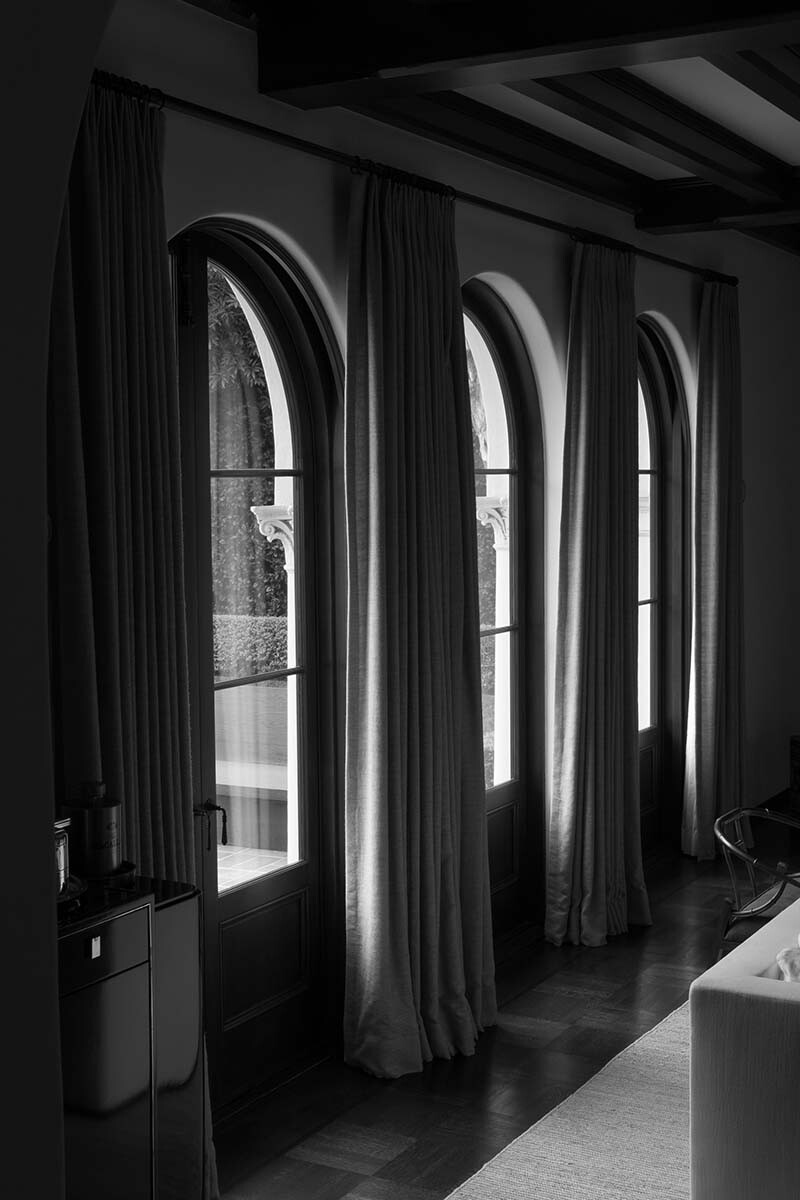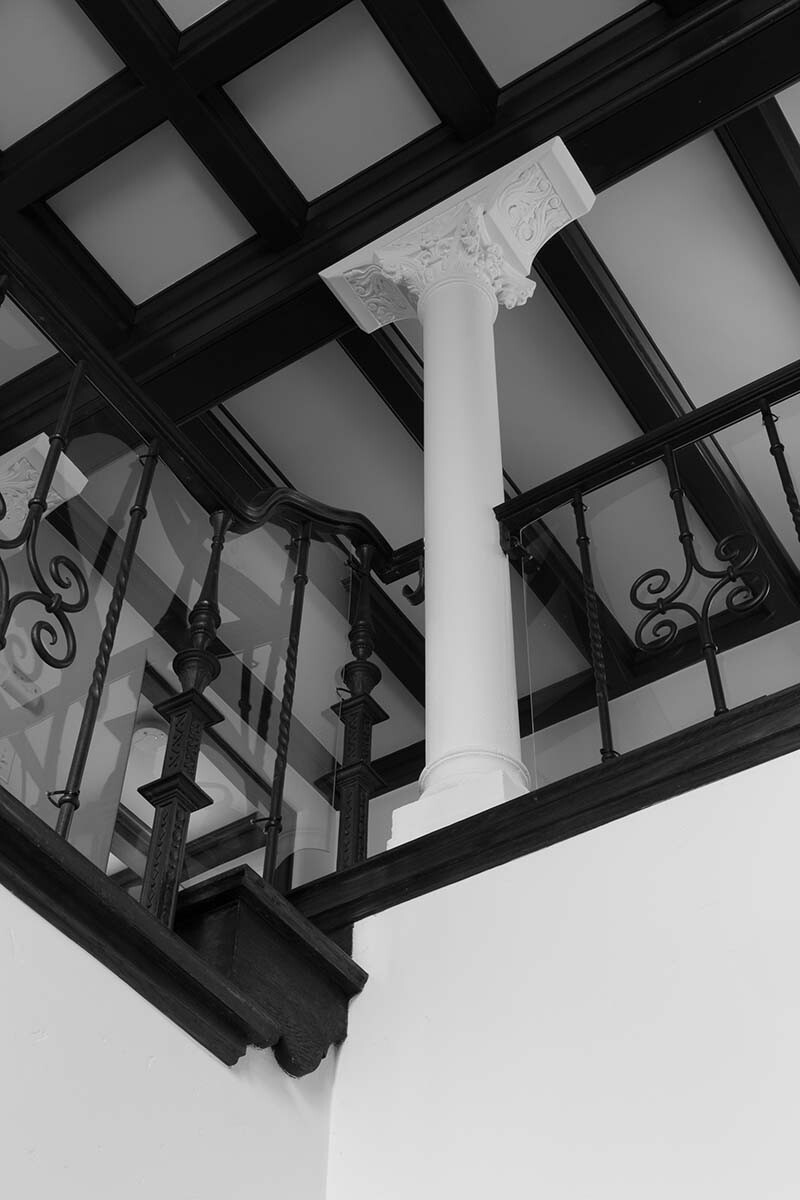Janna Ireland: Chasing Paul R. Williams Through Photography

You might not know the name Paul Revere Williams but you definitely know his work if you live in Los Angeles. The African American architect is responsible for designing over 3,000 properties in his lifetime including Kenneth Hahn Hall in DTLA, the iconic Googie-themed building at LAX, the original Saks Fifth Avenue building in Beverly Hills and the Founder’s Church in Koreatown. For the past two years, artist and photographer Janna Ireland has been honoring the work of the great Paul R. Williams through an ongoing series of photographs.
Williams was born in Los Angeles in 1894. Before he turned five, both of his parents passed away and he was sent to live in a foster home. Fortunately, Williams’ foster mother devoted herself to his education and artistic talent. Despite having a burgeoning interest in architecture, Williams was advised to find a different career in high school due to the segregation that existed in Los Angeles at the time. But Williams didn’t let the opinion of one teacher alter his path. He became a licensed architect in 1921 and eventually opened his own practice. In 1923, he became the first African American member of the American Institute of Architects.
Williams would go on to design homes for celebrities like Frank Sinatra and Lucille Ball. He designed over 2,000 homes in Los Angeles alone during his career, both for celebrity clients as well as affordable and even public housing. Over the years, a lot of Williams’ work has been demolished or altered but many of the homes he built still stand today.

“When I was 13 or 14, I started carrying a camera around every day,” Janna Ireland.
Ireland has been making photographs for over 20 years. She was first drawn to a camera at an early age, “I learned how to use a camera when I was four or five.” She credits her father, who is also a photographer, with introducing her to the world of taking photos.
Ireland studied photography at NYU in New York City where she also met her husband. Before settling down with her family, which includes two children, in Los Angeles three years ago, Ireland bounced around from Philadelphia, Oregon, Los Angeles – where she got her master’s degree –and New York City.
“I had heard his name, but didn’t really know very much about him at all,” says Ireland.
Right after moving back to Los Angeles for good in 2016, Ireland received a cold email from Barbara Bestor, a Los Angeles-based architect, about collaborating on a project centered on Paul Williams. Bestor received Ireland’s contact information from one of her grad school professors at UCLA, “She didn’t have an idea of what the project would look like,” says Ireland, “She just wanted to bring someone in to make work that was about his work.”
Ireland was immediately drawn to the idea, but had questions about her own limitations as an artist; She didn’t feel like she had enough architectural knowledge to pursue a project based on one of the most influential Black designers. “I’ve been interested in architecture for a long time, but I didn’t feel as though I had permission to approach it as a photographer. I felt that my understanding of architecture was too limited for me to approach it.”
Prior to taking on the Paul R. Williams project, Ireland’s work focused primarily on portraiture and still life photography. “When I make portraits of myself and my family they’re always very carefully planned, so I will have notes about posture and gestures and costuming. When I’m photographing a home, it’s usually a place I haven’t been before, and so there’s a discovery process. It’s about moving through the building and letting it reveal itself to me, as opposed to making all those decisions in advance.”
The initial series of photographs that Bestor commissioned culminated in a show at WUHO Gallery in Hollywood in 2017. Successfully centering a project on an unfamiliar subject gave Ireland a new sense of courage, “I’ve gotten a little braver as a photographer, and I realized that I can just teach myself something or I can go out and learn how to do something and I don’t need permission.”
Ireland has crafted a nuanced and beautiful body of work around the homes and buildings designed by Paul Williams. Shot entirely in black and white, she explores Williams’s design elements on a micro level, focusing her lens mostly on the small details of his work, “It’s more about all these little pieces of these larger structures and building a picture through a bunch of little pictures,” says Ireland. This approach translates into close ups of curved doorways, staircases and stonework in some cases. Very few of Ireland’s images feature broad landscapes.

The decision to shoot black and white in sun-soaked, colorful Southern California was a careful choice that Ireland made in advance. “That was just a mechanism for getting to the point. I wanted to be able to strip away details that I thought were extraneous.”
Ireland’s Paul Williams project fits in well within the larger context of her body of work. From a technical standpoint, she approached the Paul R. Williams project in a similar way to her other series, focusing on the small details to paint a larger picture but the project also explores themes that Ireland has focused on throughout her career. “The work that I make is about black life, specifically in the United States. Paul Williams’ work fits into my work in that way, even if it looks very different,” Ireland explains over the phone.
From the very beginning of the project, Ireland recognized an opportunity to also bring attention to an underappreciated black architect, “That is an enormous part of it for me,” she explains. Ireland says her work is motivated by a desire to see her own experiences reflected in art, in her words, she wants to make the work that she wants to see and tell the stories that she wants to hear told.

Ireland continued to photograph Williams work after her show in 2017, which lead to some publicity. Private homes are the centerpiece of the series. Prior to the show, Ireland gained access to homes through Bestor’s contacts or by reaching out to real estate agents that in turn connected her with homeowners. But after a write up in the L.A. Times last year, home owners started reaching out to her.
To this day, Ireland is still shooting Paul R. Williams-designed houses and other structures, and she doesn’t plan on stopping anytime soon. “Sometimes I just know it’s time to move on but with the Paul Williams project, because he was so prolific, it has the potential to go on forever. There’s no way to get all of it I think.”
Next year, Ireland will release her first monograph with Angel City Press, the book is currently untitled, but will focus on her Paul R. Williams project. This series has proved to be Ireland’s most successful body of work in her twenty-year journey as an artist. Today, Ireland is putting the finishing touches on her book, juggling solo and group shows, TV appearances and speaking engagements all while raising two young children and teaching photography classes at Pasadena City College.
Ireland credits her success with being in the right place at the right time, “so much of success in art is luck and who you know. It just happened that this is a subject that a lot of people in L.A. are interested in or become interested in when they hear about it. It was a lot of things that lined up.”
Top Image: Paul R. Williams in a library | J. Paul Getty Trust. Getty Research Institute, Los Angeles








